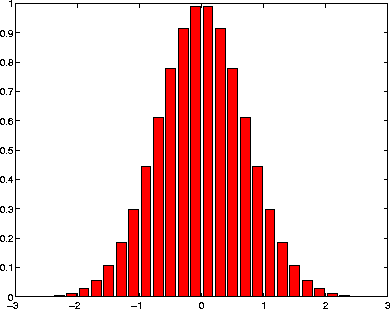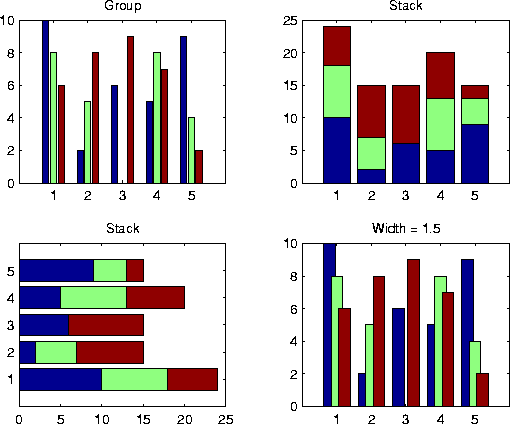Bar chart
Syntax
bar(Y)
bar(x,Y)
bar(...,width)
bar(...,'style')
bar(...,LineSpec)
[xb,yb] = bar(...)
h = bar(...)
barh(...)
[xb,yb] = barh(...)
h = barh(...)
Description
A bar chart displays the values in a vector or matrix as horizontal or vertical bars.
bar(Y)
draws one bar for each element in Y. If Y is a matrix, bar groups together the bars produced by the elements in each row. The x-axis scale ranges from 1 to length(Y) when Y is a vector, and 1 to size(Y,1), which is the number of rows, when Y is a matrix.
bar(x,Y)
draws a bar for each element in Y at locations specified in x, where x is a monotonically increasing vector defining the x-axis intervals for the vertical bars. If Y is a matrix, bar clusters the elements in the same row in Y at locations corresponding to an element in x.
bar(...,width)
sets the relative bar width and controls the separation of bars within a group. The default width is 0.8, so if you do not specify x, the bars within a group have a slight separation. If width is 1, the bars within a group touch one another.
bar(...,'style')
specifies the style of the bars. 'style' is 'group' or 'stack'. 'group' is the default mode of display.
bar(...,LineSpec)
displays all bars using the color specified by LineSpec.
[xb,yb] = bar(...)
returns vectors that you plot using plot(xb,yb) or patch(xb,yb,C). This gives you greater control over the appearance of a graph, for example, to incorporate a bar chart into a more elaborate plot statement.
h = bar(...)
returns a vector of handles to Patch graphics objects. bar creates one Patch graphics object per column in Y.
barh(...), [xb,yb] = barh(...), and h = barh(...)
create horizontal bars. Y determines the bar length. The vector x is a monotonic vector defining the y-axis intervals for horizontal bars.
Examples
Plot a bell shaped curve:
x = -2.9:0.2:2.9;
bar(x,exp(-x.*x))
colormap hsv

Create four subplots showing the effects of some bar arguments:
Y = round(rand(5,3)*10);
subplot(2,2,1)
bar(Y,'group')
title 'Group'
subplot(2,2,2)
bar(Y,'stack')
title 'Stack'
subplot(2,2,3)
barh(Y,'stack')
title 'Stack'
subplot(2,2,4)
bar(Y,1.5)
title 'Width = 1.5'

See Also
bar3, ColorSpec, patch, stairs, hist
[ Previous | Help Desk | Next ]

